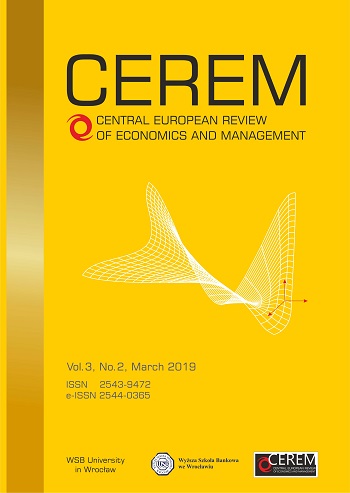Austerity policies in the Eurozone: How they affect youth unemployment?
DOI:
https://doi.org/10.29015/cerem.753Słowa kluczowe:
Monetary unions, fiscal consolidation, sustainable policies, youth unemployment.Abstrakt
Aim: Analyse the effects of stabilization policies on youth unemployment, using government deficit besides the use of fiscal policy by the supply side; aimed to characterize the economic framework conditions under which fiscal policy could reduce youth unemployment.
Design/Research methods: We consider an economic framework featuring the use of monetary and fiscal rules within a monetary union. In this scenario, that should be representative of the Eurozone, we will analyse the effects of stabilization policies when dealing with a financial crisis which produces contractive effects on output and on employment. We will pay special attention to the conservativeness of the central bank, the degree of austerity of the fiscal authorities and the initial level of government debt. Those characteristics prove to be crucial for the sustainability of economic policies packages based on fiscal consolidation and the use of fiscal policy instruments by the supply side, when trying to deal with unemployment. And given that in the financial crisis effects have been hit Eurozone countries in a different manner, we will also differentiate monetary union’s member countries according with their government debt and their unemployment path.
Conclusions/findings: Fiscal authorities should be no austere for fighting youth unemployment, when using fiscal policy by the supply side. In other words, when optimizing their loss function, they should give more weight to the output stabilization goal that to the government deficit reduction.
Originality/value of the article: Allowing for the use of both monetary and fiscal policy rules, in the scenario of a monetary union, our results could help us to stablish the conditions under which fiscal policy could help to alleviate youth unemployment.
Bibliografia
Ahlborn M., Wortmann M. (2017), Output gap similarities in Europe. Detecting country groups, Center for European Governance and Economic Development Research Discussion Papers, no. 305, Georg-August Universität Göttingen, Germany.
Barrios S., Langedijk S., Pench L. (2010), EU fiscal consolidation after the financial crisis. Lessons from past experiences, Economic Paper 418, Dirección General de Asuntos Económicos y Financieros, Comisión Europea.
Bertola G. (2017), European unemployment revisited. Shocks, institutions, integration, „Research in Economics”, vol. 71 no. 3, pp. 588-612.
Blanchard O.J. (2004), Explaining European unemployment, NBER Reporter, Summer.
Bajo-Rubio O., Díaz-Roldán C. (2009), Does the balance of payments constrain economic growth? Some evidence for the new EU members, „Post-Communist Economies”, vol. 21 no. 1, pp. 41-46.
Díaz-Roldán C. (2017), Fiscal performance in monetary unions. How much austerity should be allowed?, „Panoeconomicus”, vol. 64 no. 1, pp. 61-76, http://www.doiserbia.nb.rs/img/doi/1452-595X/2017/1452-595X1600021D.pdf
Díaz-Roldán C. (2018), On the effectiveness of fiscal policies by the supply side in monetary unions, Universidad de Castilla-La Mancha, Ciudad Real, mimeo.
European Central Bank (2013), The importance and effectiveness of national fiscal frameworks in the EU, „Monthly Bulletin”, no. 2 (February), pp. 73-88.
European Commission (2008), Recommendation of the European Commission 2008/867/EC, of October 3.
European Commission (2017), Press release, May 30.
Gómez S., Gómez E., Bardí C., Barón J. (2016), El camino hacia el empleo juvenil, Observatorio empresarial contra la pobreza, Fundación Tomillo y Fundación CODESPA.
Picatoste J., Ruesga-Benito S., González-Laxe F. (2016), Economic sustainability and possibilities of action for the states, in the case of monetary integration. Some notes for reflection, „Progress in Industrial Ecology. An International Journal”, vol. 10 no. 1, pp. 16-33.
Rozmahel P., Grochová L.I., Liztman M. (2014), Evaluation of competitiveness in the European Union. Alternative perspectives, „Procedia Economics and Finance”, vol. 12, pp. 575-581.
Pobrania
Opublikowane
Numer
Dział
Licencja
Autor przenosi nieodpłatnie na Wyższą Szkołę Bankową we Wrocławiu , bez ograniczeń terytorialnych, majątkowe prawa autorskie do tego utworu w rozumieniu ustawy z dnia 4 lutego 1994 roku o prawie autorskim i prawach pokrewnych ( Dz.U. 1994, Nr 24, poz. 83 ze zm. )na zasadzie wyłączności, tj. prawo do:
a) wyłącznego używania i wykorzystania utworu w dowolnej działalności przez Wyższą Szkołę Bankową we Wrocławiu, w szczególności w działalność Biblioteki Cyfrowej uruchomionej przez Wyższą Szkołę Bankową we Wrocławiu
b) wytwarzania, utrwalania i zwielokrotniania egzemplarzy utworów wszelkimi technikami, w tym techniką drukarską, reprograficzną, zapisu magnetycznego oraz techniką cyfrową, w szczególności ich zwielokrotniania poprzez dokonywanie zapisów na płytach typu CD,
c) zamieszczenia wybranych fragmentów utworu w celach promocyjnych w publikacjach, materiałach promocyjnych, w sieci Internet oraz sieciach wewnętrznych typu Intranet Wyższej Szkoły Bankowej we Wrocławiu,
d) wprowadzania utworu do pamięci komputera Wyższej Szkoły Bankowej we Wrocławiu,
e) kopiowania i powielania utworu w technologiach fotomechanicznych lub innych znanych w dniu zawarcia umowy (fotokopie, kserokopie itp.),
f) przetworzenia dzieła na formę elektroniczną i nieograniczonego rozpowszechniania w sieci Internet.


